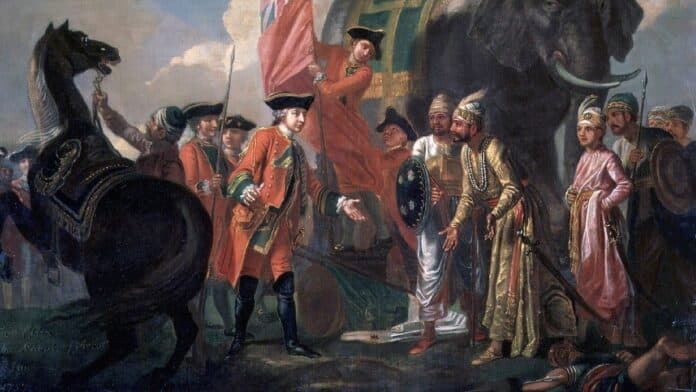The Battle of Plassey was significantly fought on June 23, 1757, between the British East India Company and the Nawab of Bengal, Siraj-ud-Daula. It was one of the turning points in the history of India as it led to the establishment of British rule over the Indian subcontinent. The battle was fought at Plassey, near Murshidabad in present-day West Bengal, India. The British East India Company, under the leadership of Robert Clive, emerged victorious in the battle, which marked the beginning of British dominance in India.
In this article, we will learn about the Battle of Plassey and Buxar, a pivotal moment in Indian history that marked the end of the Mughal Empire and the beginning of British rule in India. We will explore the background and context of the battle, the key military tactics and technology used by both sides, and the political and social implications of the East India Company’s victory.
Contents
The Battle of Plassey was fought between
The Battle of Plassey was fought between the forces of the British East India Company, led by Robert Clive, and the army of Siraj-ud-Daula, the Nawab of Bengal. The battle took place on June 23, 1757, near the village of Plassey in present-day West Bengal, India. The British East India Company was supported by several Indian allies, including Mir Jafar, one of Siraj-ud-Daula’s commanders, who had agreed to support the British in exchange for being made the new Nawab of Bengal.
Background
The British East India Company established its presence in India in the early 17th century. The company had established trading posts and had gained significant influence in the Mughal courts. The company had also gained control over several coastal areas in India, including Madras, Bombay, and Calcutta. The company’s profits largely depended on the trade of textiles, especially cotton, silk, and spices. However, by the mid-18th century, the company’s fortunes had started to decline, and it was facing stiff competition from the French East India Company.
At the same time, Bengal was one of the richest provinces in India, with a flourishing textile industry and a thriving agriculture sector. The Nawab of Bengal, Siraj-ud-Daula, had come to power in 1756 after the death of his grandfather, Alivardi Khan. Siraj-ud-Daula was young and inexperienced, facing several challenges to his rule. His nobles were dissatisfied with his policies, and there were reports of British agents fomenting trouble in his court.
The British East India Company saw an opportunity in the instability in Bengal and decided to intervene. The company had a substantial army and navy, which it had built over the years, and it saw an opportunity to expand its influence in Bengal. The company’s directors in London approved the plan, and Robert Clive was sent to India to lead the company’s forces.
The Battle
Clive arrived in India in 1756, and he immediately began to build alliances with local rulers who were opposed to Siraj-ud-Daula. Clive also began to build up the company’s army, which included Indian soldiers known as sepoys. Clive was able to recruit several experienced Indian soldiers, who had served in the armies of the Mughal emperors.
The British East India Company planned to capture the city of Calcutta, which was the center of British trade in Bengal. In June 1756, Siraj-ud-Daula attacked Calcutta and captured the city. The incident became known as the Black Hole of Calcutta, as several British prisoners were allegedly locked up in a small room, leading to many deaths due to suffocation. The incident outraged the British, and Clive saw an opportunity to strike back.
In early 1757, Clive led a force of 3,000 soldiers, including 800 European soldiers and 2,200 Indian sepoys, to Plassey, near Murshidabad. Siraj-ud-Daula had gathered a large army of around 50,000 soldiers, which included cavalry, infantry, and artillery. However, Siraj-ud-Daula was overconfident, and he did not expect the British to attack.
The Battle of Plassey began on June 23, 1757, and lasted several hours. Clive’s army was outnumbered, but it was better equipped and better trained than the Nawab’s army. The British had several cannons, which they used to devastating effect.
The Indian soldiers, including Siraj-ud-Daula’s artillery, were no match for the British cannons. The British also had better discipline and tactics, which allowed them to maintain their formation despite Nawab’s attempts to break through their lines. The Indian soldiers were also demoralized by the betrayal of Mir Jafar, one of Siraj-ud-Daula’s commanders, who had agreed to support the British in exchange for being made the new Nawab of Bengal.
In the end, the Battle of Plassey was a decisive victory for the British. The Nawab’s army suffered heavy casualties, while the British lost only 22 men. Siraj-ud-Daula fled the battlefield, but he was later captured and executed by Mir Jafar’s forces. Mir Jafar was made the new Nawab of Bengal, and he agreed to pay a large sum of money to the British East India Company. The company also gained control over several territories in Bengal, which allowed it to expand its trade and influence in the region.
Impact
The Battle of Plassey was a significant event in Indian history, marking the beginning of British rule in India. The British East India Company’s victory at Plassey gave it control over one of the richest provinces in India, and it paved the way for further expansion of British influence in the region. The British used the wealth and resources of Bengal to build a powerful empire in India, which lasted for over 200 years.
The Battle of Plassey also had a profound impact on Indian society and politics. The defeat of Siraj-ud-Daula and the rise of Mir Jafar marked the beginning of the decline of the Mughal Empire, which had ruled India for over 300 years. The battle also exposed the weaknesses of the Indian rulers and their inability to resist foreign powers. The British used this weakness to their advantage and established a system of indirect rule, which allowed them to control India without direct military intervention.
Battle of Plassey and Buxar
The Battle of Plassey and the Battle of Buxar are two significant battles in Indian history that occurred during the same period and involved the British East India Company and the Indian rulers.
The Battle of Plassey fought in 1757, was a decisive victory for the British East India Company over the Nawab of Bengal, Siraj-ud-Daula. The battle took place near the town of Plassey in Bengal, and it marked the beginning of British rule in India. The British victory at Plassey gave the company control over Bengal, one of the wealthiest provinces in India, and it allowed the company to expand its trade and influence in the region.
The Battle of Buxar fought in 1764, was another significant battle between the British East India Company and the combined forces of the Mughal Empire, the Nawab of Awadh, and the Nawab of Bengal. The battle took place near the town of Buxar in present-day Bihar, and it was a decisive victory for the British. The battle marked the end of the Mughal Empire’s influence in India and paved the way for the British to expand their control over the country.
The Battle of Buxar was significant because it solidified the British East India Company’s dominance over India. The company’s victory at Buxar gave it control over Bihar, Bengal, and Orissa, which allowed it to establish a firm grip on the economy and politics of the region. The battle also exposed the weakness of the Indian rulers, who were unable to coordinate their forces effectively and were outmatched by the British military tactics and weaponry.
The Battle of Plassey and the Battle of Buxar are connected in many ways. The victory of the British East India Company at Plassey paved the way for their expansion in India and made the Battle of Buxar possible. The lessons learned by the British at Plassey allowed them to refine their tactics and strategies for future battles, including the Battle of Buxar. Moreover, the victory at Buxar cemented the company’s control over India and paved the way for their eventual establishment of British colonial rule.
The Battle of Plassey and the Battle of Buxar were significant events in Indian history that marked the beginning of British rule in India. The victories of the British East India Company at Plassey and Buxar allowed them to establish control over Bengal, Bihar, and Orissa, which laid the foundation for British colonial rule in India. The battles also exposed the weaknesses of the Indian rulers and paved the way for the eventual decline of the Mughal Empire.
The Key Military Tactics and Technology Used in These Wars
The Battle of Buxar in 1764 was fought between the British East India Company forces and a coalition of Indian rulers, led by the Mughal Emperor Shah Alam II. Both sides used a variety of military tactics and technology to try to gain the upper hand in the battle.
The British East India Company had an advantage in terms of military technology, as they had access to advanced weapons such as muskets and artillery, which gave them a significant edge on the battlefield. They also had a highly disciplined and well-trained army, which was able to execute complex maneuvers and maintain tight formations even under fire.
One of the key tactics used by the British was to deploy their artillery in a forward position, which allowed them to fire on the enemy from a safe distance and disrupt their formations. The British were also skilled at using their cavalry to exploit gaps in the enemy line and attack from the flanks.
On the other hand, the Indian coalition forces relied more on traditional tactics such as massed infantry charges and cavalry charges. While these tactics could be effective in certain circumstances, they were less effective against the British, who were able to disrupt their formations with their superior firepower.
Despite these differences, the Indian coalition forces were able to put up a strong resistance, and the battle was fiercely contested on both sides. Ultimately, however, the British were able to leverage their superior technology and tactics to secure a decisive victory, which gave them control over the rich provinces of Bengal, Bihar, and Orissa and laid the foundation for their eventual conquest of the Indian subcontinent.
While it is true that the British East India Company had superior weapons and military technology during the Battle of Buxar and the Battle of Plassey, other factors contributed to their victory as well. One of the most important factors was the strategic alliances that the British had formed with various Indian rulers and factions, which allowed them to field a larger and more diverse army than their opponents.
The British were also able to take advantage of the disunity and infighting among the Indian rulers, which weakened their ability to resist the British advance. In addition, the British had developed more efficient administrative and logistical systems, which gave them an advantage in terms of mobilizing and supplying their troops. Finally, the British had also developed a more effective training and discipline regime for their soldiers, which allowed them to fight more effectively on the battlefield. Therefore, while the British did have an advantage in terms of their military technology, their victory at Buxar was also due to a combination of other factors, including strategic alliances, administrative efficiency, and tactical prowess.
Conclusion
The Battle of Plassey was a watershed moment in Indian history, marking the beginning of British rule in India. The British East India Company’s victory at Plassey gave it control over Bengal, which allowed it to expand its trade and influence in the region. The battle also had a profound impact on Indian society and politics, as it exposed the weaknesses of the Indian rulers and paved the way for the decline of the Mughal Empire. The Battle of Plassey is a reminder of the complex and often violent history of India, and it continues to shape the country’s identity and relationship with the rest of the world.
The Battle of Buxar was a significant turning point in Indian history, marking the end of the Mughal Empire and the beginning of British domination in India. The East India Company’s victory at Buxar secured its control over the rich provinces of Bengal, Bihar, and Orissa, laying the foundation for British rule in India for the next two centuries. The battle was notable for its decisive outcome and the British East India Company’s use of superior military tactics and weapons, including the use of artillery and disciplined infantry, which proved to be crucial in its eventual conquest of the Indian subcontinent. While the legacy of the Battle of Buxar is still debated by historians today, it is clear that it was a pivotal moment in the history of India and the British Empire, setting the stage for the tumultuous events that would follow in the coming centuries.
Sources
- Edwardes, M. (2017). The battle of Plassey and the conquest of Bengal. Pickle Partners Publishing.
- Ring, T., Watson, N., & Schellinger, P. (2012). Buxar. In Asia and Oceania (pp. 188-191). Routledge.
- Chatterjee, A. K. (2018, June 23). The Battle of Plassey was fought on June 23, exactly 261 years ago.
- Harrington, Peter (1994), Plassey 1757, Clive of India’s Finest Hour; Osprey Campaign Series #36, London: Osprey Publishing, ISBN 1-85532-352-4
- Hill, S.C., ed. (1905), Bengal in 1756–1757, Indian Records, vol. 1, London: John Murray, ISBN 1-148-92557-0, OCLC 469357208
- Anand, A. (2022, May 14). The Bengal Conundrum: How Bengal Suffered under Mughal Rule and Hindus Fought for Survival. News18.
- Lewis, M. D. (Ed.). (1962). The British in India: imperialism or trusteeship? Heath.
- Fortescue, Sir John William (1899). A History of the British Army. Vol. II. London: Macmillan and Co.
FACT CHECK: We strive for accuracy and fairness. But if you see something that doesn’t look right, please Contact us.
DISCLOSURE: This Article may contain affiliate links and Sponsored ads, to know more please read our Privacy Policy.
Stay Updated: Follow our WhatsApp Channel and Telegram Channel.












